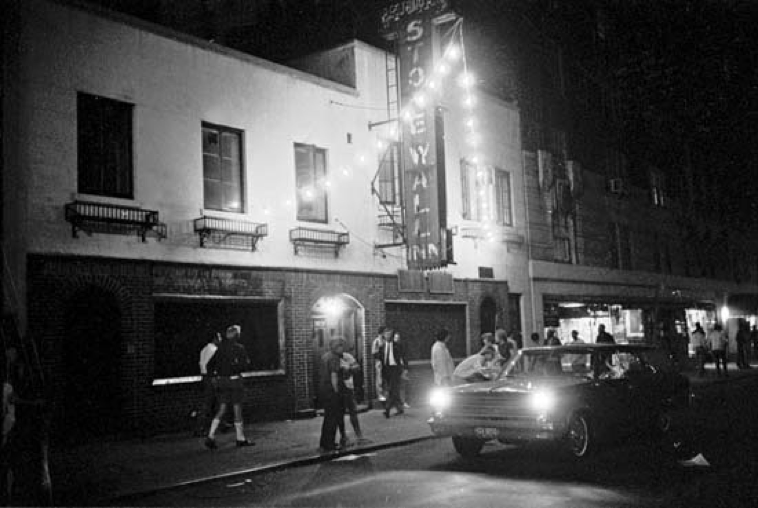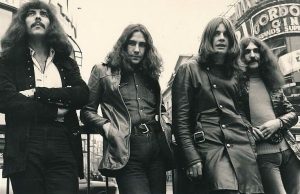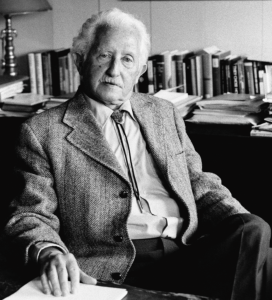Forced to retreat into the very establishment in which they were running people out off, the fearful and injured eight detectives were able to push and create a path for themselves. Once inside, they boarded the doors of the Stonewall Inn and called for backup. At the moment, the bar served as their only protection from the angry rioters outside. Before they knew it the Stonewall Inn, ironically their only sanctuary at the moment, was breaking. Windows around them were shattering and Molotov cocktails were thrown in. Flames, although not very strong, began to build around them.1 Soon after, the front door was broken down leaving the detectives exposed and vulnerable. One would agree that feelings of dread, lonesomeness, and hopelessness were the emotions that filled the detectives, as would anyone in their situation. However, these were familiar everyday feelings that the rioters outside had long felt. But how did we get to this moment?

On the hot summer day of June 28, 1969, a rather morbid atmosphere filled the air of the Stonewall Inn as people were mourning the recent death of Judy Garland, a popular actress known for her role as Dorothy in The Wizard of Oz. She was greatly adored in the gay community.2 Sadly, the gay community could not say that they felt any adoration or appreciation as Garland was receiving. What they felt was quite the opposite. This is why many gays frequented the Stonewall Inn. The Stonewall Inn, located in Greenwich Village, a neighborhood of Manhattan, New York, was a home to many homosexual individuals, as they could gather there free of social and political judgement. Outside of their safe haven, all hid their true identities and selves, putting on a façade for others to see. When some men were “outed” or labeled as being as homosexual, only true hell was to follow, with no light at the end of the tunnel. Homosexuals were treated as abominations by strangers, their own families, and even the law. The year 1952 marked the establishment of the McCarran-Walter Act. This act was a revision to an existing immigration law that allowed one to be deported, or to be denied entry to the country if one were a “psychopathic personality.” Conveniently, a homosexual fitted the profile of a psychopathic personality in the eyes of the law. Homosexuality was even treated as a mental disease at this time. Arrested homosexuals were often sent for psychiatric evaluation, and most were found as having psychotic tendencies and personalities. Psychologist and psychiatrist would perform counseling and treatments in order to “cure homosexuals and revert them back to their original state.” There were even extreme cases in which lobotomies were performed on homosexual individuals. However, people believed that science wasn’t the only method of treating homosexuality. The other treatment was religion and prayer. American church congregations had been taught to believe that homosexuality was a form of sin and that the devil was to blame. In order to rid oneself of sin and these temptations, one could “pray the gay away.” Although not to the same degree, we still see both these problems today, especially within the church. In 1969, one could even find themselves on the front page of the newspaper, shamefully describing their sexual orientation. Soon after, they would lose their job, insurance, credit, and family. Homophobia doesn’t discriminate, and all these problems were also known to effect homosexual women as well.3

The Stonewall Inn was also a popular spot where many came to illegally drink and dance. Bisexuals and drag queens also frequented the bar. At this time in the United States (1969), much like it is in current day Russia, it was illegal to cross dress, dress as a drag queen, and serve alcohol to homosexuals. These “laws” were constantly being broken; so, police would perform frequent raids on bars that they suspected of housing gays and ones that they thought were illegally serving alcohol without a license.4 On this specific night, the police obtained a warrant and were scheduled to perform a routine raid on the Stonewall Inn at around 2:00 AM, when the people inside would least expect it. The officers believed they were adequately prepared as no serious problems or resistance were known to occur when homosexuals were involved. Little did they know they were in for a rude awakening. As they barged into the bar, two bright-white lights flashed on the dance floor, a well-known signal within the gay community. This indicated to everyone that the police were present. Immediately, the eight detectives demanded for everyone to leave the bar, including the staff, and line up outside with their identification. The people inside, though angry and irritated, followed the orders given to them. With individuals lined up against the Stonewall Inn outside, a police wagon then pulled up, opened, and officers then began to arrest multiple drag queens, people without proper identification, and staff. As people were being detained, enraged onlookers yelled “Pigs,” “Abuse of Power,” and “Police Brutality” to the detectives. An uproar then followed. No one knows today who exactly started the riots, but one can agree that the community finally snapped. The years of abuse, the treatment directed to Lesbian, Gay, Bisexual, Transgender, and Queer (LGBTQ+) individuals, and the fact that they were to be arrested for being who they were, finally lead up to that moment. That was the moment when they had had enough. And at this moment, multiple people reported that a drag queen escaped from the hands of one of the detectives, turned around, and punched them in the face. This one punch would be responsible for starting a revolution.5
This action triggered almost everyone involved to begin throwing bottles, stones, and other objects at the detectives and their vehicles. As you can imagine, things only escalated from there, leading the police then to run back into the bar for shelter. Rioters managed to break off a parking meter and began to beat the door of the Stonewall with it. Once that shelter was breached, drag queens and homosexual men threw punches at the police as the police threw punches at them. Quickly word spread through the city and hundreds of onlookers, mostly from the LGBTQ+ community, gathered outside the bar. The uproar then continued to grow tremendously.

When reinforcements arrived, more specifically the Tactical Patrol Force, they fought head-on with all the rioters. The Tactical Police Force were dressed in helmets with visors and were in body armor. They also yielded tear gas, riot shields, and other weapons. The Tactical Police Force linked arms and attempted to sweep the streets clear of people but they inevitably failed. Their numbers were small compared to how many rioters were present. From this, they had no other choice but to charge into the crowd. Men and women were brutally clubbed to the ground, and police force members were injured from different objects being thrown and blunt force from rioters. It wasn’t until after 4 AM, that the police were officially withdrawn.6 However, the riots did not end. Some rioters were arrested and charged with assault, resisting arrest, selling alcohol without a license, harassment, and for many other reasons. Even after the withdrawal of the police, people roamed the streets and continued to gather together chanting their opinions on the police and everyday people.

The Stonewall Riots continued for days to come and grew more violent with each day. Once Greenwich Village was settled and calmer, many visited the Stonewall Inn to see the damage that was left as a result. Streets were filled with trash and graffiti was drawn on the Stonewall Inn with slogans stating, “Legalize gay bars.” Word spread across the United States of how LGBTQ+ members were tired of being oppressed and segregated, and how they would use violence if necessary, in order to be treated as equals. These riots, a foundational event, sparked many LGBTQ+ movements, gave people the confidence to oppose the government, and gave them the courage to demand that they be treated as humans and not as scoundrels. Slogans such a “gay power” and “homosexuals are human too” began to appear. In the following month of July, organizations that focused on the empowerment of gay individuals were established. The first is known as the Gay Liberation Front (GLF). Although, there are still problems being faced today within the LGBTQ+ community; such as transgendered rights, the Stonewall Rioters were key factors in their movement up the social and political ladder.7 What took place at the Stonewall Inn is a story that isn’t commonly shared or taught in history books or classes today. Regardless of the fact that the people directly involved are homosexual individuals, history is history, and it should be shared so that we are not doomed to repeat ourselves.
- Walter Frank, Law and the Gay Rights Story (New Jersey: Rutgers University Press, 2014), 32-39. ↵
- Encyclopedia of Lesbian, Gay, Bisexual and Transgendered History in America, 2004, s.v. “Stonewall Riots,” by Fred Wasserman. ↵
- Walter Frank, Law and the Gay Rights Story (New Jersey: Rutgers University Press, 2014), 22-31. ↵
- Encyclopedia of Lesbian, Gay, Bisexual and Transgendered History in America, 2004, s.v. “Stonewall Riots,” by Fred Wasserman. ↵
- Encyclopedia of Lesbian, Gay, Bisexual and Transgendered History in America, 2004, s.v. “Stonewall Riots,” by Fred Wasserman. ↵
- “4 Policemen Hurt in ‘Village’ Raid,” The New York Times, 29 Jun. 1969. ↵
- Scott Bravmann, “Stonewall, Silver Screen: Cinematic Representation and the Queer Past,” American Quarterly 48, no. 3 (September 1996): 491-499. ↵



74 comments
Arieana Martinez
I had no idea about the Stonewall Riots and it’s history. This article was very powerful and exposes the raw truth of the people in the LGBTQ community and their path to gaining the same rights to love/show their love to whomever they please in any setting they please. I got the chills reading this article, as it was very obvious to see the passion in the words that were written. It is extremely heartbreaking to see the heinous acts that the people of the LGBTQ community have had to go through and continue to endure today, showing that there is still a ways to go in modern times as well.
Daniela Duran
This is always a very controversial topic, that brings up a lot of questions and discussions. I truly believe that discrimination against homosexual people must be forbidden in all ways, and definitely the idea of it being illegal for them to be on bars, or to express who they are is wrong. They should, at all points be respected, which is by I consider that the riot was somehow justifiable. They do have human rights, because they ARE humans. It is also unfair to treat homosexuals as being mentally ill, as the article mentioned, and this is definitely something that must have made them feel oppressed and segregated. However, I must mention that the idea about the church discriminating homosexuals is completely wrong. Many people believe that the catholic church somewhat “hates” and excludes homosexuals, when the truth is that it doesn’t. The church actually teaches us to love everyone as Christ loved us, which is why we love and treat homosexuals as any other. However, what the church doesn’t allow is marriage. This is because we believe in the idea that God made marriage sacred and holy, though the pairing-up of men and women. Hence, church does not, in any way, hate or segregate homosexual individuals at all! It certainly does not allow marriage, but that is very different from being mean to them or excluding them. Sometimes we get a little confused about this, and it happened to me! So, if in doubt at any point…asking a priest is a great idea! This article certainly brings up many thoughts such as this ones regarding church, and I believe it is always nice to read about things that instruct us in terms of moral and ethics.
Indhira Mata
The LGBTQ community now has one of the biggest celebrations and festivals dedicated to them. This is so their community does not feel alone. It is amazing to see that people back then had the courage to stand up for themselves. Without their movements, there is no telling how long the acceptance of the LGTBQ community would be or if there would be one. The article was very insightful on a extremely worldwide topic. There is still so much more to be accomplished but this was the start.
Natalie Juarez
In order to not repeat history, one must know it. I appreciate the conclusion regarding LGBT+ history because many people are not aware of the struggles that LGBT+ people have faced and continue to face, despite the progress that has been made. As a proud member of the LGBT+ community myself, I wish more of our history was taught in class because there is still so much that people do not know that have affected LGBT+ people in a horrific way. Although I was aware that identifying as a homosexual was viewed to be a “mental illness” in the earlier years, I had no idea about the McCarran-Walter Act. This goes to show that learning history should not stop for a better understanding of the world and the people in it depends on it. Thank you for the well written and informative article.
Mariah Garcia
Before reading this article I hadn’t heard of the Stonewall Inn nor was I aware of where it was located. It is interesting to read such a history that isn’t shared in school. I may see why it isn’t taught in school but such a largely significant event within the LGBTQ+ community would be even more poignant now with the age of Pride in full swing around Western society. Such an event should be covered, so that we may learn from and avoid the mistakes of the past. We may ask how the detectives and police felt during the riot, but I think more importantly, it would be interesting to see the reaction from members of the LGBTQ+ community, since they have been persecuted for so long as it is.
Belia Camarena
Prior to reading this article, I had never heard about the Stonewall riots. Great job writing this article! It was really informative, and I learned a lot about the persecution and discrimination that the gay and LGBQT community faced. It is sad that they were even considered to have a mental disorder, and people went so far as to perform brain surgery on them.
Cheyanne Redman
As a member of the LGBTQ community, I can agree that the hardships faced are extremely real. It has changed for the better recently yet we still face adversity and banishment. I don’t understand how someone can judge someone else based on their own life choices in which they have no part of. This article truly did an amazing job at bringing to the table what homosexuals faced and continue to face, and I feel that this could be used as a voice for the community.
Great Article.
Caroline Bush
Interesting article! Its really sad to hear about the injustice the LGBTQ community faced during this time. This article did a really good job capturing the injustice and anger the LGBTQ community was feeling during this time. I also enjoyed the amount of details included in this article and could tell that it was very well researched. Its ridiculous that people are treated differently because of there sexual orientation and sadly its still a problem we have today. Overall this was a very interesting article over a topic that is so important to know about.
Miranda Alamilla
You would think equality is pretty simple being that you’re just supposed to treat everyone with the same form of respect and that everyone should have the same opportunities as someone else. However, this article clearly states that equality is not always so simple. The struggles that the LGBTQ community have faces in the past, and still face today, cause events like these. There should be a separation between church and state – i.e. you can’t just “pray away the gay”. Equality should apply to every human, not just the straight white ones.
Noah Laing
I wasn’t aware of this event, but after reading this article and seeing the motive behind the riot, it basically can be seen as pushing for equality. To this day equality hasn’t been reached in every aspect which is very shameful for the human population as a whole. In this article it’s clear that members of the LGBTQ community and their views were not accepted, which is understandable because humans will never all share the same views in every aspect of life, but what isn’t understandable is treating others as less and not respecting them as an equal human. No matter someone’s preferences or beliefs, equality should always be a constant amongst humans.